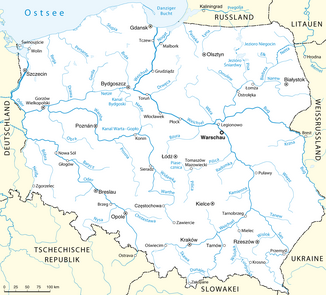Warta
The Warta ( Polish Warta ) is an 808 kilometer long right tributary of the Oder in Poland .
course
The Warta, the most important tributary of the Oder , rises on the slope of the Krakow-Czestochowa Jura above the Polish town Mrzygłód at Kromołów east of the city Zawiercie , very near Upper Silesia and on the same plateau on which the Vistula tributaries Pilica and Przemsa their sources to have. It first flows northwards via Częstochowa (Czestochowa) , enters the Polish lowlands near Radomsko ( Radomsk ), flows in this, often multi-armed, to Sieradz and Warta , then after taking up the Ner again westwards via Konin and Pyzdry ( Peisern ), where it takes up the Prosna on the left and crosses over to the territory of the historic Prussian province of Posen . It flows here in a westerly direction via Śrem ( Schrimm ), then, turning north, via Posen to Oborniki ( Obornik ), whereupon it continues its course to the west, flowing past Międzychód ( pear tree ) and the Obra to the left at Skwierzyna ( Schwerin ) records. After having assumed a northerly direction, it goes westwards for the third time at Nowe Polichno ( Pollychen ), where it picks up the nets on the right , passes Gorzów Wielkopolski ( Landsberg an der Warthe ) and now flows in a south-westerly direction until it, 180 m wide, below Kostrzyn nad Odrą (Küstrin) flows into the Oder from the right.
When it flows into the Oder, the Warta is even longer than the main river. However, it is significantly less watery than the Oder, as its catchment area is almost exclusively in the relatively dry Polish lowlands. Its river basin covers 44,650 km². The Warta Estuary National Park was established at the estuary in 2001 .
The Warta is connected to the Vistula via the Netze , the Bromberger Canal and the Brahe .
shipping
In 1618, Elector Johann Sigismund (Brandenburg) granted Polish merchants free shipping on the Warta in the Treaty of Trebisch (near Schwerin an der Warthe ). At the beginning of the 20th century the Warta was navigable over a distance of 425 km (from Konin ); the mean water depth on the Prussian side was 2.00–2.20 m.
Namesake and national symbol
The Warta is the namesake for the younger stage of the Saale Ice Age , during which the southern ridge in particular was created. As a result of the third partition of Poland, the Warta and Vistula found their way into the Polish national anthem Mazurek Dąbrowskiego as symbols of freedom .
photos
Ernst Henseler : The Warta (1900)
Warta in Poznań
Warta in Wronki
Warta in Gorzów Wielkopolski
literature
- Heinrich Berghaus : Land book of the Mark Brandenburg and the Markgrafthum Nieder-Lausitz , Volume 3, Brandenburg 1856, pp. 86-102 ( books.google.de )
- Heinrich Girard : The north German plain, especially between the Elbe and the Vistula, is shown geologically . Berlin 1855, pp. 233-251 ( books.google.de )
- Warthe , encyclopedia entry in: Meyers Großes Konversations-Lexikon . 6th edition, Volume 20, Leipzig / Vienna 1909, pp. 392-393 ( Zeno.org ).
Web links
Individual evidence
- ↑ a b Warthe , encyclopedia entry in: Meyers Großes Konversations-Lexikon . 6th edition, Volume 20, Leipzig / Vienna 1909, pp. 392-393 ( Zeno.org ).
- ↑ Otto Dalchow: The cities of the Wartheland. A contribution to the settlement and regional studies of the province of Poznan . Noske, Borna / Leipzig 1910, p. 47.




